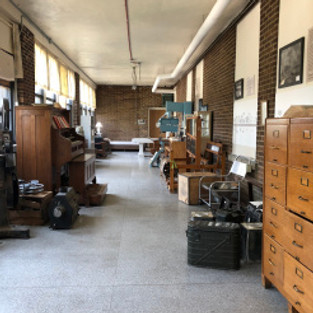Jamestown
- czikmund
- Jun 3, 2019
- 7 min read
Before last week, I had never been to an insane asylum. Maybe I still haven’t been to one. Much has changed since my grandfather was admitted to the North Dakota State Hospital for the Insane – a harsh name for a place purportedly dedicated to helping people. None of the original buildings are still standing but they have drawings and pictures of the way it used to look. The so-called Insane Asylum was established in 1885, four years before North Dakota was granted statehood. It’s only one of two North Dakota institutions to predate statehood; the other is the University of North Dakota. Today, the mental health facility is called the North Dakota State Hospital, a kinder gentler designation. Located in Jamestown, we often refer to the hospital as simply “Jamestown” as if this one hospital defines the entire community. Since I was in the neighborhood, some ninety miles away in the up and coming city of Fargo, I thought I would visit the place where my father’s father died while bending over to tie his shoes.
Trivia Question: Did you know that many people claim the Fargo and Moorhead area is one of the largest cities between Minneapolis and Seattle? At a combined population of about 230,000+, it amazes me they could find enough people to brave the cold dark winters. And, ah-hum, what about Spokane, WA?
2nd Trivia Question: Did you know that the show Fargo is largely filmed in its twin city, Moorhead, MN? I totally understand why a producer would prefer the evocative name Fargo to the functional name of Moorhead, accurate or not.
Anyway, in this land of my Bohemian-Czech ancestors, I had one burning question I wanted to be answered:
Was the definition of schizophrenia back then – in the years of the Great Depression – the same as it is today?
I’ll dispense with the suspense and say that I did not find a specific answer to my “historical lens of sanity” question, but I learned a few facts that may help draw some conclusions:
In 1931, the year my grandfather and uncle were patients at “Jamestown”, there were 1600 patients living there.
In 2019, there are approx. 200+ patients. These tortured souls are considered to be extreme cases on the mental disorder spectrum. The hospital no longer admits folks who want some R&R from the daily grind of farm chores.
The museum, located on the fourth floor of the Administration building, had some interesting restraint systems that you can try on. If you dare.
Patient records dating back to the late 1880s show meticulous record keeping and gorgeous penmanship, for what that’s worth. Before the days of computers, people took the time to write well.
If you can find the entrance to the nondescript museum, you deserve a prize, and it probably means you hijacked someone on their way between buildings to give you directions.
The inverse relationship of the hospital’s population compared to the total population suggests people were “put away” for reasons that, when viewed through the mental health lens of today, would seem egregious. The hospital reached its peak population of 2200 in 1949, after which it experienced a steady decline until it dropped to today’s number.
On the last point – about the museum entrance – I made the mistake of first approaching a building that was located at the front of the complex. I pushed the intercom. Nothing. I saw people walking around inside. I pushed the intercom again. Nothing. I caught someone’s eye. She mouthed something back to me. This happened three times before she got so frustrated, she came to the bolted door, poked her nose out and said,
“Someone will be with you.”
I managed to squeeze in my question about the museum location to which she impatiently said go left then left. Slam. A few seconds later someone came out, this person a little calmer.
“I’m going to the building, you can follow me,” the calm woman said.
That’s how I found the museum entrance through a stairwell in the back. The calm woman explained that the first building I tried to enter is shared with the minimum security prison next door. This is the reason for the cautiousness. Admittedly, my curly hair was turning to frizz on the breezy spring day and it’s possible I looked slightly deranged. I have to say, the prison yard next door with its three rows of circular barbed-wire fencing was a bit off-putting.
I had certain expectations. For the museum entrance, I expected a large foyer, welcoming visitors from out of state, like myself, with orderlies on hand, holding straight jackets behind their back in case of emergency. In contrast, entering through the stairwell, I felt as if I were sneaking in a back way. And, I hysterically wondered if I would be able to leave. One Flew Over the Cuckoo’s Nest wrecked me of sanitariums in the same way Jaws destroyed my trust of swimming in the ocean.
Before leaving California for Fargo, I had called NDSH and spoken to a woman who I’ll call Clara. Clara has been the main admin for the hospital for the past forty years. She took an immediate dislike to me when I requested to meet with someone to ask “a few questions”. I called several times, trying to penetrate the defensive armor of Clara or go around her, all ending in getting sent back to Clara and her spitting reprimands at me like I was a journalist looking to expose her employer for the lobotomies still practiced in the basement. I didn’t have any intention of mounting an expose, but I found it curious the amount of suspicion I created with a simple request for an open-ended conversation. Then it became clear. On the day of my visit, a news story broke in the local newspapers. It revealed that NDSH had lost its accreditation in part due to patient safety issues and possibly because of the murder that took place there in March when a patient strangled an employee who was cleaning his bathroom.
Back in the 1930’s people could be committed to the State Hospital on the word of almost anyone. In my grandfather’s case, he burned down the neighbor’s haystack. Family lore says the neighbor reported him to the authorities who came and hauled him off to Jamestown. Looking at the economic conditions that the US faced in the ’30s might give better clues as to why he was incarcerated for an argument turned vengeful. At the outset of the depression, farming communities were financially hard-hit, struggling to feed their large broods of children (Dad’s family is Catholic if that helps explain their large brood). This combined with the more personal tragedy that my great grandfather (Dad’s father’s father) shot and killed himself in their barn. No one knows why my great grandfather, a successful landowner, decided to end it all. Dad’s Bohemian Czech family had had their share of hardships which were mostly real and could help explain why future generations would be ill-equipped at coping.
Contrary to my irrational fears, I was free to leave at the end of my museum visit. When I offered to pay for the brochure, Clara waved the fee and gave me an additional book on the history of the hospital (cover value of $14.95). Apparently, I was more likable in person than I was on the phone. Or, maybe people are more accepting when they’re face-to-face and you’re not just some voice from radical-thinking California.
A copy of the letter from the Insane Asylum to my grandmother discusses the matter of payment, asking for a $40 parole deposit upon my uncle’s departure. Deposit implies that you get it back if he returns? Or? Another letter requested money for an X’mas present that should be sent in the form of cash or a check made out to the hospital. Don’t send a gift the letter advised. hmmm.

Letters from my uncle to his mother suggest he was reasonably happy at the hospital where patients were allowed to roam the sweeping grass carpeted grounds at will.

Historical reports filed by the hospital’s management indicate the poor conditions for patients and workers and suggest a plan for improvement. Perhaps the work of hospital administrators served to improve conditions for the employees and patents since 1914.

All-in-all, NDSH is a unique place, preserving a part of the past that many would prefer to have swept under the carpet. The self-guided museum allows the general public to experience firsthand the evolution of mental health care since 1885. In a room filled with natural light, restraint devices and ledgers, a visitor can see how far humanitarianism has come in the diagnosis and treatment of mental illness. Even so, I left the sanitarium feeling unsettled. I had been exposed to its history and experienced the reality of being misjudged.
How can I return to my previous state of blissful ignorance?
Sometimes, I think what separates each of us is our ability to overcome a bad experience while keeping ourselves intact. Being lucky enough to have one less harmful exposure to an event that could push the boundaries of what a human being can reasonably absorb. Having experienced one less rejection hurled our way that can’t be ignored. Having one less day of feeling lost and alone. Is it really just one less thing going wrong that can make a difference between a happy life and a tortured one? Maybe it’s simply one more day of saying, “I can take it. Nothing can break me.”
I left Jamestown thinking the same way about Psychiatric care as I do about Oncology: grateful the occupation exists, that it continues to evolve and better itself with each person it heals and hoping, above all else, I never need either one.
After all this introspection, I needed a change of pace and I found one in the shape of a rather large bison.
Jamestown is also famous for the heard of buffalo that roam near its Frontier Village. Dakota Miracle, a descendant of White Cloud, is one of the albino buffaloes in residence. The Lakota Nation holds white buffaloes sacred based on a legend about an important peace pipe brought to them via a beautiful woman who turned into a white buffalo, or something like that. The white I saw looked a bit shaggy still trying to shed its fur for the summer. The story sounded better than the picture looks.
My day with bison and asylums ended with my having a new perspective on the land of my ancestors. They were farmers, some of them better at it than others, but they all survived by working the land. Some had fiery tempers that got them into trouble with the neighbors and some didn’t live to see the other side of the Great Depression. I salute the bison of the Great Plains who struggled to survive the slaughter of their population when families like mine invaded from Europe. A lot has changed in these parts since the US government passed the Homestead Act of 1862 which enticed immigrants to plant the fertile Red River Valley. I mean, the Fargo & Moorhead region is one of the largest metropolitan areas between Seattle and Minneapolis. We’ve learned to revere Native American traditions and honor the white buffalo. We are less likely to commit sane people to insane asylums. We don’t even have insane asylums anymore. We openly accept our past in all of its ugliness, perhaps as a means to not repeat it. And, we tell ourselves each time we are tested, “I can take it. Nothing can break me.”































Comments